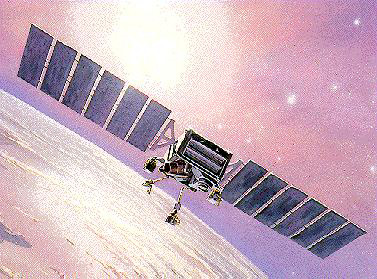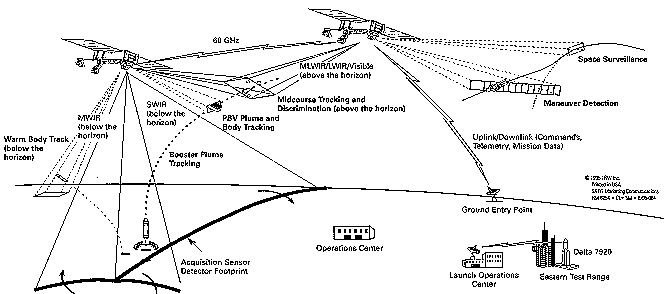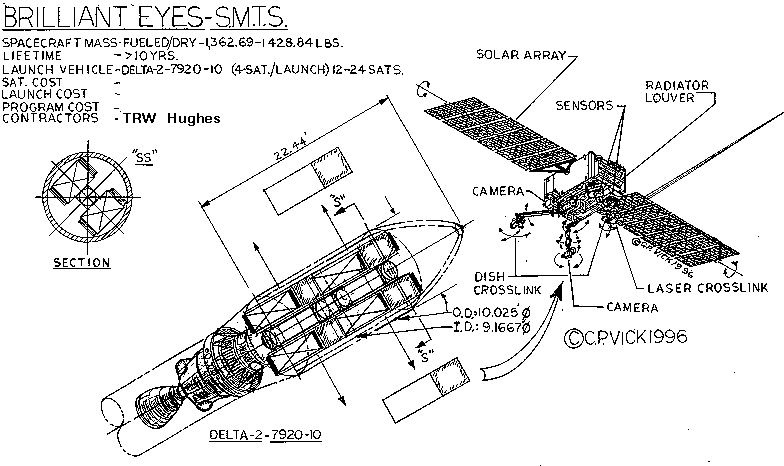| In addition, Brilliant Eyes provides
more data for accurate impact point and time predictions than existing
systems, greatly reducing the number of units that it takes for operating
inhibiting countermeasures. Brilliant Eyes satellites will also be used
for surveillance of objects in space, helping to prevent collisions between
satellites, spacecraft and space debris. Brilliant Eyes is currently in
the demonstration and validation phase.
-
-
- SMTS is the low earth orbit component
of the SBIRS architecture. Its unique capability to track missiles throughout
their trajectory - not just during the "hot" boost phase - allows
the system to effectively cue missile defense systems with accurate targeting
data. It is particularly useful to National Missile Defense and against
the longest range theater missile threats. SMTS also has the potential
to address other SBIRS requirements, such as Technical Intelligence and
Battlespace Characterization. A SMTS constellation optimized for national
missile defense would consist of 21 satellites in three orbit planes. One
optimized for all four SBIRS missions would contain at least 28 satellites
in four orbit planes. The baseline SMTS program plans a deployment decision
in 2000, with a first launch in 2006.
-
- According to prime contractor TRW:
-
- Working in pairs for stereoscopic viewing,
the satellites develop precise location, velocity and acceleration data
on the missile warhead and associated debris or decoys.
-
- The currently planned interceptors can
engage threats at ranges beyond the capabilities of their associated radars.
Using data generated by SMTS, these interceptors can use that excess capability
to negate attacking missiles far from friendly forces and population centers.
Early intercepts allow SMTS to assess the attacking missile's status so
that additional interceptors are launched only if needed. This shoot-look-shoot
option reduces interceptor inventory requirements. Early intercepts made
possible by SMTS extend the boundaries of the defended area some three
to five times.
-
- SMTS can precisely cue ground radars;
allowing them to limit operations until a hostile missile is within their
range. This reduces the threat from homing anti-radiation missiles -- likely
players on modern battlefields.
-
- The constellation provides global surveillance
for ballistic missile launches within seconds. Early detection allows for
precise launch point determination, enabling theater forces to destroy
the launcher before more missiles can be fired.
-
- The program is currently developing two
Flight Demonstration System (FDS) satellites, which will be launched in
FY 1999 for two years of on-orbit tests and data collection. TRW and Hughes
are teamed for executing the FDS program.
-
- Acceleration of the SMTS deployment to
the year 2002 in response to Congressional interest to support an early
National Missile Defense capability, would force the FDS to be down-scoped
to emphasize NMD only, not a system fully capable of performing all the
IR missions.
-
-
Constellation 12-24 satellites in multiple rings at low altitude
Satellites <1500 lbs each
Launch Vehicle Delta 7920 (up to 4 satellites per launch)
Payload Wide field-of-view acquisition sensor (SWIR)
Narrow field-of-view tracking sensor
(MWIR,MLWIR, LWIR and visible)
Communications 60 GHz between satellites
44/20 GHz to ground
S-band to satellite control network
Electrical Power 1.5 kW silicon solar arrays
40 amp-hr. nickel-hydrogen battery
Lifetime 10 years
Availability 99%
-
- ___
-
- References
-
- * FY97 Research & Development
Descriptive Summary
-
- * Statement of Operational Objective
11 June 1996
- * Commerce Business Daily 1 April
1996
- * Scenarios 1 May 1996
- * Synopsis 15 May 1996
- * Industry Day Briefing 200k Powerpoint
file - 8 May 1996
- * Industry Day Briefing a normal browser-viewable
extract - 8 May 1996
- * Contractor Library
-
- * Some Industry Viewgraphs
|


